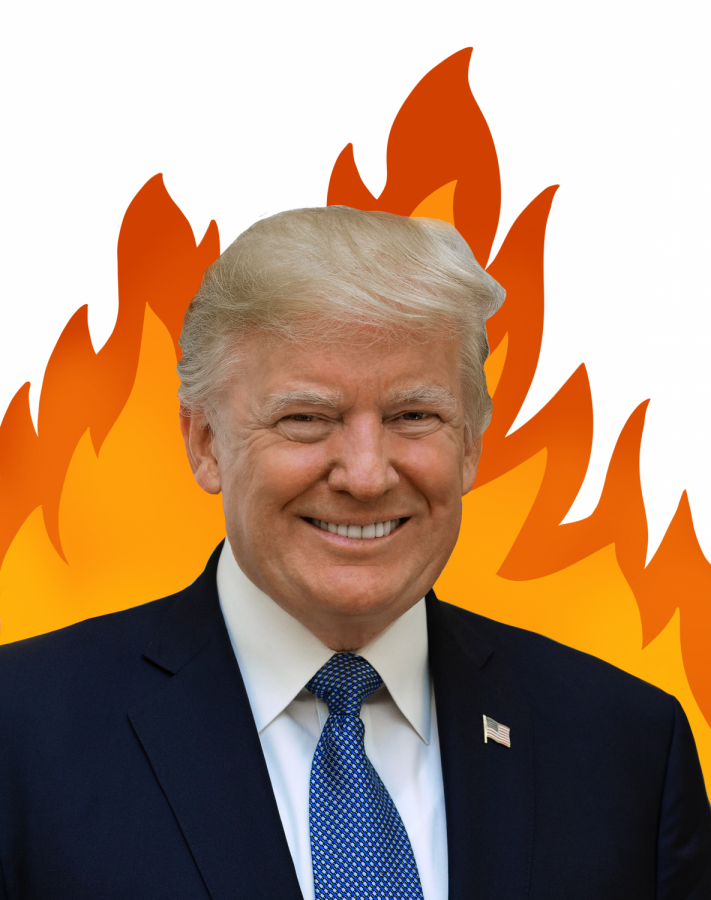The Tide’s View: Trump’s climate change policy fuels the wildfires of California
Photo Courtesy of Wikimedia Commons | Graphic by Valerie Wang
President Donald Trump smiles in front of the California wildfires.
December 5, 2019
Six thousand fires per year. Two hundred acres burnt per year. Over the past century, California has warmed by approximately three degrees Fahrenheit, triple the global average. This increase in temperature dehydrates plants and soil, leaving the trees, shrubs, and rolling grasslands of the state dry and primed to burn. As a result, wildfires have been a common occurrence in California in recent years.
This year is no exception. The current fire season is projected to end in December, yet there have already been over 6,402 fires recorded, with 250,349 acres of land burnt. These fires have resulted in widespread destruction of buildings and power grids and deaths, as well as horrific fatalities across the state. “Watching the news and seeing live pictures of California’s state right now is just so devastating that we have to do something to save ourselves,” sophomore Monica Escalante said.
Although wildfires are a natural part of California’s ecosystem and autumn is the traditional high-risk season for fires to break out, forests have become more fire prone and the wildfire season has lengthened by several months. With sea levels rising and diseases spreading, the California wildfires are only another symptom of increasingly apparent climate change. Yet President Donald Trump refuses to see the overarching connection to climate change, much less have enough knowledge about the environment to give informed advice or action to combat the growing calamity.
Trump’s blatant ignorance can be seen in his numerous comments on California’s wildfire crisis. On Nov. 3, he tweeted, “The Governor of California, @GavinNewsom, has done a terrible job of forest management.” He also suggested that the governor open up water lanes to combat the wildfire: “California desperately needs water, and you can have it now!”
Not only is his comment unnecessarily inflammatory, but his comments are also simply incorrect. First of all, most of the fires are burning in the shrubs or grasslands, not forests. Even if forests were the issue, the California state government owns a mere three percent of its state forest lands, demonstrating the president’s misunderstanding of the whole situation.
Trump also claimed that California has the most severe wildfires, citing it as a reason that the state government is not fighting the fires effectively. However, Fortune Magazine found that Alaska lost almost ten times the amount of land in the past year; the reason it is not as highly publicized is because it is not nearly as populated, and therefore as dangerous, as California. By perpetuating false information, Trump reveals that he is more concerned with antagonizing others rather than actually fighting climate change.
This sentiment is best represented in California Governor Gavin Newsom’s response to Trump’s tweets: “You don’t believe in climate change. You are excused from this conversation.”
Trump’s disbelief in climate change dangerously exacerbates the issue. It can be seen in his track record against environmental policies: in 2017, he announced that he would be withdrawing the US from the Paris Agreement, a global fight against climate change, mocked the established science of human-caused warming as a hoax, and directed the Environmental Protection Agency to roll back nearly every federal policy designed to curb the heat-trapping fossil-fuel pollution that is one of the major causes of global warming. Now, he’s threatening to cut federal funds for the fight against California wildfires.
Trump has many steps he needs to take to resolve this issue. He must begin listening to environmentalists and experts on this topic, and then factor in their opinions when determining the next course of action to combat the wildfires. “If you want to know who is right, ask the scientists,” Loyola Law School professor Jessica Levinson said in an interview with CBS L.A.
So far, scientists and fire officials agree that climate change—the strong winds and dried out shrubs produced by a changing environment—are the real culprits of these devastating wildfires. When talking about climate change in relation to the fires, meteorologist Brian Garcia said, “I don’t necessarily like to call it ‘the new normal,’ because the new normal implies we’ve hit an equilibrium of some kind and we haven’t.” He continues,“We’re going to continue to warm and continue to see the impacts of this changing climate.”
As a result, the most important course of action would be for Trump to recognize that climate change exists. In terms of the California wildfires, a belief in climate change can continue federal funding to fight the fires and save the lives of thousands of people in California. The wildfires will not go away on their own. Only with dedicated efforts—and a belief in climate change—will the fires be extinguished.


